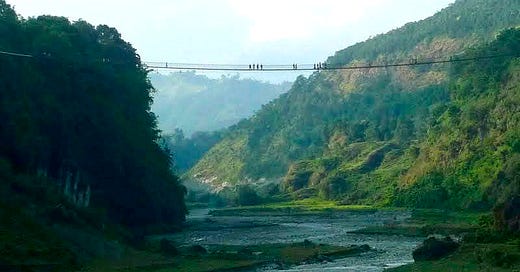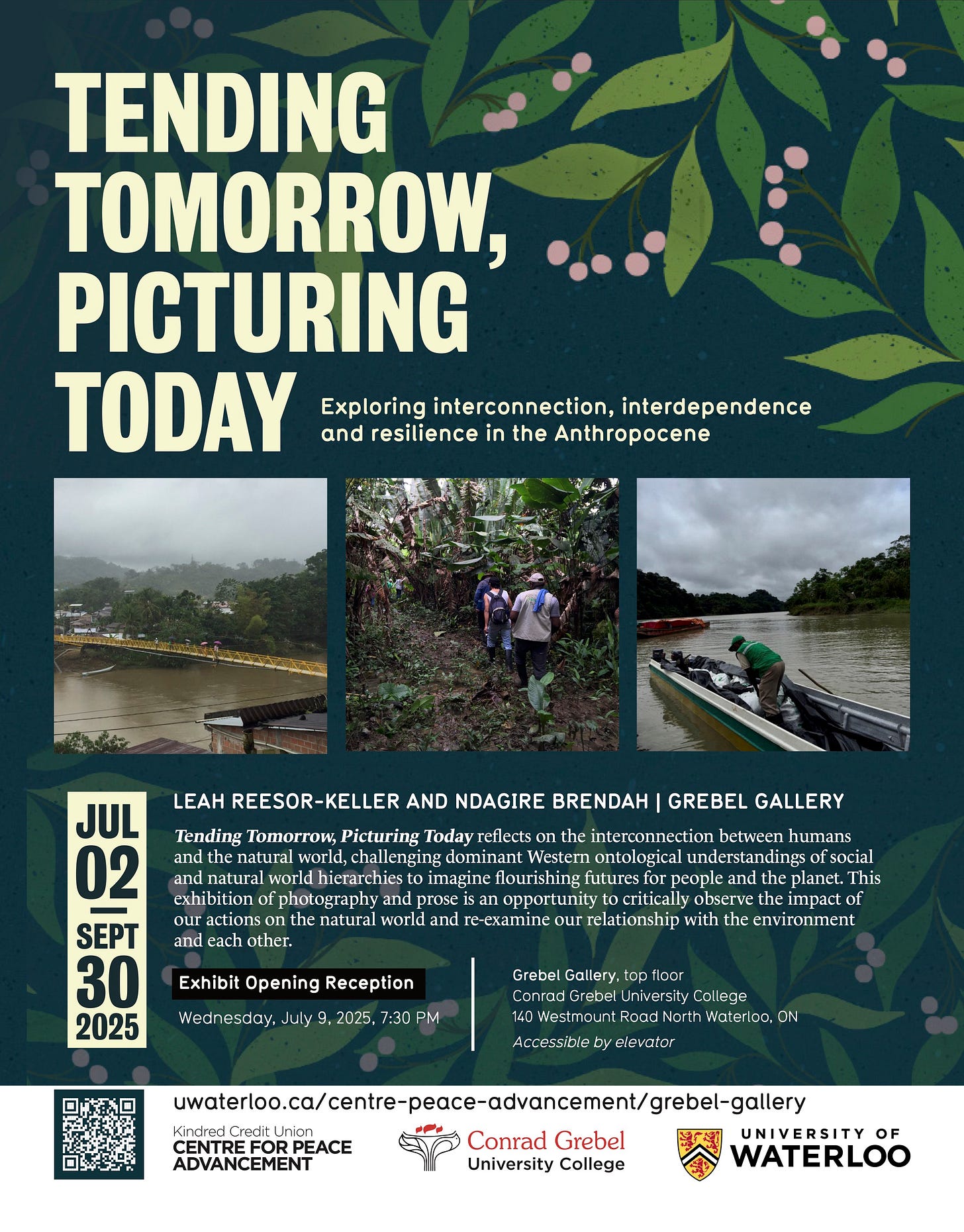Dear Imagining Change readers,
Celebrating 2 years of this newsletter, and 1 year of Tending Tomorrow being out in the world. Thank you for being part of this journey!
This month I’m thinking about maps - the guides we make to help us navigate the world around us. Tending Tomorrow is a book, but really it is a map; it’s about navigating and making sense of the world we live in, and that my children are inheriting, and then recording that journey to help readers navigate their own way forward.
Read on for my thoughts on why leaders need to see themselves as map-makers, and for info on upcoming events online and in-person that will help you find your own orientation and grounding in this time of rapid global change.
Thanks for being here!
-Leah RK
Ten years ago the ground under my feet shifted and rolled so much that I lost my sense of orientation in space. I held onto my spouse, Luke, with one hand, and onto our flat’s bedroom door frame with the other, braced against the groundswell of the earthquake tremouring through Kathmandu and across the central and eastern part of the country. We were safe, and our neighbourhood on the edge of the city relatively untouched. Thousands of others were not so fortunate, with over 9,000 lives lost that day and in the severe aftershocks that followed. Precious lives and livelihoods losts, cultural heritage destroyed, and the landscape fundamentally altered. Due to the shifting underground rock structures, 5,000 springs and wells dried up, completely changing centuries of village life in rural areas.
In the those early days after the major earthquake and aftershocks, I remember feeling so disoriented as we worked Nepali civil society organizations and community partners on reconstruction and livelihood recovery projects. What could be take for granted before was no longer there. Whether that was walking through Kathmandu’s ancient medieval squares and seeing only rubble where historic temples had been, or working with partners in rural areas trying to figure out what recovery looks like when springs that a mountain village relied on were suddenly not there any more. Existing maps were no longer reliable.
These days, I feel this lingering disorientation in space. The haunting spectre of climate change with smoke from faraway wildfires drifting through my backyard. The community I grew up in unrecognizeable to me in places where rapid development paved over the irreplaceable farmland. And shifting sands of the global rise of authoritarianism and war, a pendulum swing away from stable democratic institutions and human rights to a rhetoric of exploitation, extraction, dominance and control. We need new maps - the world we thought we knew is changing, and we can’t quite see the shape of the new world emerging around us.
This spring, theology giant Walter Brueggemann passed away. His book The Prophetic Imagination has been been a major influence on my own thinking and theological development. When I began as executive minister with Mennonite Church Eastern Canada in 2020, during the height of the pandemic when it seemed that the whole world had changed overnight, I drew inspiration from a 2011 On Being interview with Brueggemann and host Krista Tippett. In the sermons I preached over Zoom, and later in person when the world opened up again, I often included this quote from Brueggemann, referencing the passage from Isaiah 43 on God doing a new thing, making ways in the wilderness and streams in the desert:
The amazing contemporaneity of this material is that the issues are the same, that the world we have trusted in is vanishing before our eyes, and the world that is coming at us feels like a threat to us. We can’t quite see the shape of it. I think that is where the church and the preachers of the church have to live.
Maps are symbolic representation of the world around us, created to communicate landscapes to others. To make a map requires that you take a broad view, often an aerial view, holding in your mind how different parts of a landscape connect to each other. Maps can be carved into rock faces, like the Bedolina petroglyphs map dating back to the Iron Age in what is now Italy. Maps can be held in songs, like the spirituals of the Underground Railroad that held coded navigation information to aid enslaved African Americans seeking freedom. Maps are held in Wardaman People’s Dreaming Tracks, or songlines, that link stars, landmarks and rock paintings in songs that guide navigation across the Australian continent.
To be a leader right now is to be a map-maker. Whether in the Brueggemann sense of being a prophetic preacher, or someone who brings others together on school councils, neighbourhood groups, or who leads others in businesses or organization, in politics, leaders need to be helping others to make sense of changing landscapes. In this time of rapid change, one of the core functions of leaders is to find our own grounding in space and time, and then to offer that to others, to provide sense-making and re-orientation to bring others along into the emerging world. To help people find connection, community and landmarks to guide a path forward when the guideposts we have relied on are no longer there, or look different than they used to.
In that spirit, here are three things leaders need to do as map-makers and navigators of change to guide others along.
Decide on your cardinal directions. This is your foundation for navigation. By this, I mean set your values. It can be impossible to see ahead, and many times you must rely on taking the next step visible to you without being able to see further ahead. Take the next necessary step according to your values, your cardinal directions.
Care less about hope, and more about courage. You need dogged determination to find your way through, not dependent on whether you feel hopeful or despondent on any given day. Cultivate the courage to follow your cardinal directions forward.
Draw a map that is easy for others to follow. Maps are communication. Describe how things have changed, describe what the landscape looks like now. Describe where you are situated in this landscape, and help others to situate themselves in the new landscape. Make it easy for others to see where they fit now, and the steps ahead to where they may want to go.
This is not easy work. It is chaotic at times, messy, and requires constant learning, unlearning and re-learning. It is work that needs others - we learn about the shifting world around us and how we are each affected differently through relationships across social and geographical positions. But little by little, map by map, song by song, story by story, we are finding our way to be human, to live and survive together in a vast changeable world.
Sending so much love and solidarity to everyone navigating towards peace, justice and dignity for all. Elbows linked, as people across borders and nations who dream of a flourishing world for all.
In a time marked by political upheaval, ecological crisis, and deep uncertainty, how do we make space for lament—and where do we find signs of hope? How might we make sense of the unsettled terrain around us? Join us for an evening of honest reflection and collective grounding as we explore these questions together.
Panelists Paul Okoye, Dr. Kim Penner, Rev. Dr. Hyung Jin (Pablo) Kim Sun, and Leah Reesor-Keller will guide us through a rich conversation from the vantage points of Diversity, Equity, and Inclusion; Organizational Change; and Theology. Each will speak from their own disciplinary and lived experience, naming the disorienting realities we face and lifting up where they see hope emerging.
Learn more and register for this free online event: juniacentre.ca/events
I’m really excited about collaborating with photographer Ndagire Brendah for this exhibit at the Grebel Gallery, University of Waterloo, that brings themes from Tending Tomorrow together with images of how people and the environment are connected. The exhibit is free and open to the public from Jul 2 - Sep 30th. Join us on July 9th for the opening reception! Details and RSVP here.






